#subterranean world
Explore tagged Tumblr posts
Text

Ojer Kaslem by Ryan Pancoast
One of gods found in the subterranean world beneath Ixalan. Ojer Kaslem represents wisdom which is why her appearance is that of the abuela (grandmother).
While discussing this character, it was said there may be a few llamas and alpacas and one or two capybara seen in this set. I just want to see a chinchilla or two.
#mtg#magic the gathering#ixalan#lost caverns of ixalan#subterranean world#gods#fantasy card game#wotc#wizards of the coast
11 notes
·
View notes
Text
Unearthing Wonders: A Journey into the Depths of Jules Verne's "A Journey to the Centre of the Earth"
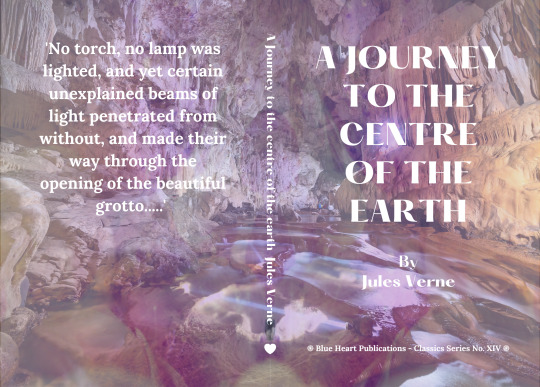
Jules Verne's "A Journey to the Centre of the Earth" is an extraordinary odyssey that transcends the limits of imagination and plunges readers into the heart of an enigmatic subterranean world. Originally published in 1864, this timeless classic continues to captivate audiences with its gripping narrative, scientific curiosity, and the boundless spirit of adventure that permeates every page.
The story begins in Hamburg, Germany, where Professor Otto Lidenbrock discovers an ancient Icelandic manuscript that hints at a passage to the center of the Earth. Fueled by an insatiable thirst for knowledge and adventure, the professor, along with his reluctant nephew Axel and their guide Hans Belker, embarks on a perilous journey beneath the Earth's surface.
Verne's narrative unfolds as a first-person account penned by Axel, offering readers a front-row seat to the awe-inspiring discoveries and challenges encountered during their subterranean expedition. The trio navigates through labyrinthine caves, encounters prehistoric creatures, and witnesses geological marvels, each episode building a sense of wonder and excitement.
One of the novella's strengths lies in Verne's ability to blend scientific knowledge with the art of storytelling. The meticulous attention to geological and physical details reflects Verne's fascination with science and exploration. The vivid descriptions of the underground landscapes, illuminated by the trio's improvised lighting, create a palpable sense of the unknown and evoke a spirit of scientific discovery.
Verne's characters are both endearing and emblematic of the scientific curiosity prevalent in the 19th century. Professor Lidenbrock embodies the relentless pursuit of knowledge, Axel represents the inquisitive but apprehensive observer, and Hans exemplifies the silent determination of the guide. Together, they form a trio that captures the essence of exploration and scientific inquiry.
The novella's enduring appeal lies in its timeless themes—curiosity, exploration, and the indomitable human spirit. Verne invites readers to reflect on the nature of discovery and the insatiable desire to unravel the mysteries of the world. As the characters delve deeper into the Earth, the narrative becomes a metaphorical journey into the uncharted realms of human potential and the boundless possibilities of scientific exploration.
In addition to its narrative prowess, "A Journey to the Centre of the Earth" serves as a precursor to the science fiction genre, influencing generations of writers and filmmakers. Verne's imaginative storytelling laid the groundwork for tales of subterranean adventures and became a benchmark for science fiction's capacity to transport readers to unexplored realms.
In conclusion, Jules Verne's "A Journey to the Centre of the Earth" stands as a testament to the enduring power of storytelling and the insatiable curiosity that drives human exploration. The novella's blend of scientific precision, vibrant characters, and enthralling adventures continues to inspire readers to embark on their own journeys of discovery, inviting them to unearth the wonders hidden beneath the surface of the known world.
Jules Verne's "A Journey to the Centre of the Earth" is available in Amazon in paperback 14.99$ and hardcover 22.99$ editions.
Number of pages: 310
Language: English
Rating: 9/10
Link of the book!
Review By: King's Cat
#Jules Verne#A Journey to the Centre of the Earth#Science fiction#Adventure#Exploration#Subterranean world#Professor Otto Lidenbrock#Axel#Hans Belker#Icelandic manuscript#Geological marvels#Prehistoric creatures#Scientific curiosity#19th-century literature#Exploration literature#Human spirit#Curiosity#Uncharted realms#Science and storytelling#Precursor to science fiction#Subterranean adventures#Geology#Journey narrative#Underground landscapes#Literary classic#Timeless themes#Human potential#Metaphorical exploration#Influence on literature#Exploration of the unknown
3 notes
·
View notes
Text

#fantastic#digitalart#subterranean world#hidden#aiart#ai#mystical creatures#art#cave entrance#glowing crystals
0 notes
Text
Unearthing Wonders: A Journey into the Depths of Jules Verne's "A Journey to the Centre of the Earth"
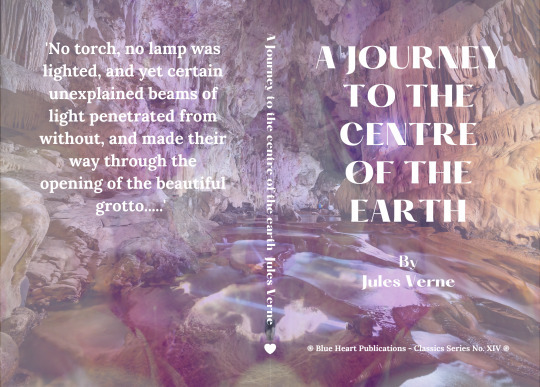
Jules Verne's "A Journey to the Centre of the Earth" is an extraordinary odyssey that transcends the limits of imagination and plunges readers into the heart of an enigmatic subterranean world. Originally published in 1864, this timeless classic continues to captivate audiences with its gripping narrative, scientific curiosity, and the boundless spirit of adventure that permeates every page.
The story begins in Hamburg, Germany, where Professor Otto Lidenbrock discovers an ancient Icelandic manuscript that hints at a passage to the center of the Earth. Fueled by an insatiable thirst for knowledge and adventure, the professor, along with his reluctant nephew Axel and their guide Hans Belker, embarks on a perilous journey beneath the Earth's surface.
Verne's narrative unfolds as a first-person account penned by Axel, offering readers a front-row seat to the awe-inspiring discoveries and challenges encountered during their subterranean expedition. The trio navigates through labyrinthine caves, encounters prehistoric creatures, and witnesses geological marvels, each episode building a sense of wonder and excitement.
One of the novella's strengths lies in Verne's ability to blend scientific knowledge with the art of storytelling. The meticulous attention to geological and physical details reflects Verne's fascination with science and exploration. The vivid descriptions of the underground landscapes, illuminated by the trio's improvised lighting, create a palpable sense of the unknown and evoke a spirit of scientific discovery.
Verne's characters are both endearing and emblematic of the scientific curiosity prevalent in the 19th century. Professor Lidenbrock embodies the relentless pursuit of knowledge, Axel represents the inquisitive but apprehensive observer, and Hans exemplifies the silent determination of the guide. Together, they form a trio that captures the essence of exploration and scientific inquiry.
The novella's enduring appeal lies in its timeless themes—curiosity, exploration, and the indomitable human spirit. Verne invites readers to reflect on the nature of discovery and the insatiable desire to unravel the mysteries of the world. As the characters delve deeper into the Earth, the narrative becomes a metaphorical journey into the uncharted realms of human potential and the boundless possibilities of scientific exploration.
In addition to its narrative prowess, "A Journey to the Centre of the Earth" serves as a precursor to the science fiction genre, influencing generations of writers and filmmakers. Verne's imaginative storytelling laid the groundwork for tales of subterranean adventures and became a benchmark for science fiction's capacity to transport readers to unexplored realms.
In conclusion, Jules Verne's "A Journey to the Centre of the Earth" stands as a testament to the enduring power of storytelling and the insatiable curiosity that drives human exploration. The novella's blend of scientific precision, vibrant characters, and enthralling adventures continues to inspire readers to embark on their own journeys of discovery, inviting them to unearth the wonders hidden beneath the surface of the known world.
Jules Verne's "A Journey to the Centre of the Earth" is available in Amazon in paperback 14.99$ and hardcover 22.99$ editions.
Number of pages: 310
Language: English
Rating: 9/10
Link of the book!
Review By: King's Cat
#Jules Verne#A Journey to the Centre of the Earth#Science fiction#Adventure#Exploration#Subterranean world#Professor Otto Lidenbrock#Axel#Hans Belker#Icelandic manuscript#Geological marvels#Prehistoric creatures#Scientific curiosity#19th-century literature#Exploration literature#Human spirit#Curiosity#Uncharted realms#Science and storytelling#Precursor to science fiction#Subterranean adventures#Geology#Journey narrative#Underground landscapes#Literary classic#Timeless themes#Human potential#Metaphorical exploration#Influence on literature#Exploration of the unknown
0 notes
Text
The Architecture of Rain World: Layers of History
A major theme in Rain World's world design that often goes overlooked is the theme of, as James Primate, the level designer, composer and writer calls it, "Layers of History." This is about how the places in the game feel lived-in, and as though they have been built over each other. Here's what he said on the matter as far back as 2014!

The best example of this is Subterranean, the final area of the base game and a climax of the theme. Subterranean is pretty cleanly slpit vertically, there's the modern subway built over the ancient ruins, which are themselves built over the primordial ruins of the depths. Piercing through these layers is Filtration System, a high tech intrusion that cuts through the ground and visibly drills through the ceiling of the depths.
Two Sprouts, Twelve Brackets, the friendly local ghost, tells the player of the "bones of forgotten civilisations, heaped like so many sticks," highlighting this theme of layering as one of the first impressions the player gets of Subterranean. Barely minutes later, the player enters the room SB_H02, where the modern train lines crumble away into a cavern filled with older ruins, which themselves are invaded by the head machines seen prior in outskirts and farm arrays, some of which appear to have been installed destructively into the ruins, some breaking through floors.
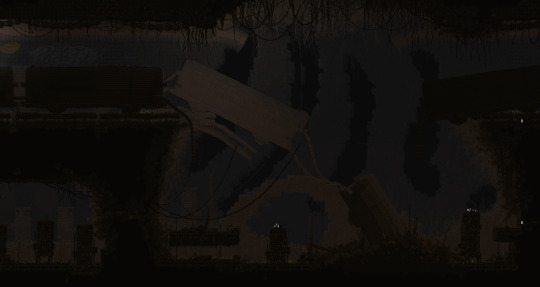
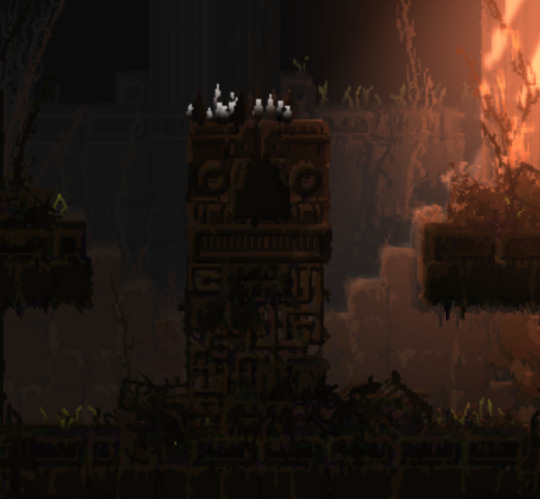
These layers flow into each other, highlighting each other's decrepit state.
The filtration system, most likely the latest "layer," is always set apart from the spaces around it. At its top, the train tunnels give way to a vast chasm, where filtration system stands as a tower over the trains, while at the bottom in depths, it penetrates the ceiling of the temple, a destructive presence. (it's also a parallel to the way the leg does something similar in memory crypts, subterranean is full of callbacks like that!)


Filtration system is an interesting kind of transition, in that it is much later and more advanced than both of the areas it cuts between. This is a really interesting choice from James! It would be more "natural" to transition smoothly from the caves of upper subterranean to the depths, but by putting filtration system in between, the two are clearly demarcated as separate. The difference in era becomes palpable, the player has truly found something different and strange.
Depths itself is, obviously, the oldest layer not only of subterranean but of the game itself. The architecture of Depths has little to do with the rest of the game around it, it's a clear sign of the forgotten civilisations that our friend Two Sprouts, Twelve Brackets showed us, there's not actually that much to say about it itself, it's mostly about how it interacts with the other layers of subterranean.
That said, Subterranean is far from the only case of the theme of layers of history. It's present as soon as the player starts the game!
The very first room of the game, SU_C04, is seemingly a cave. It is below the surface, the shapes of it are distinctly amorphous rather than geometric. (well. kind of, it doesn't do a very good job of hiding the tile grid with its 45 degree angles.)

But let's take a closer look, shall we?

See that ground? it's made of bricks. The entire cave area of outskirts is characterised by this, the "chaotic stone" masonry asset is mixed with brickwork, unlike the surface ruins which are mostly stone. This, seemingly, is an inversion of common sense! The caves are bricks and the buildings are stone. This is not, however, a strange and unique aspect but a recurring motif.
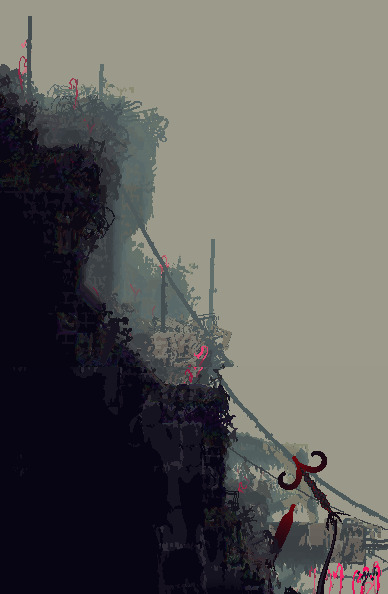
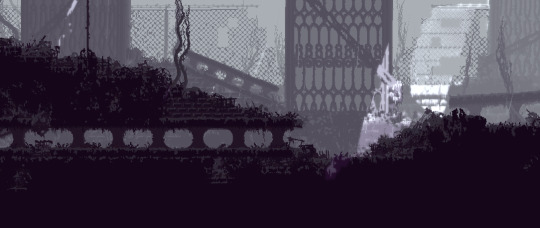
This occurs enough in the game for it to be clearly intentional, but why would materials such as bricks be used in otherwise natural looking terrain?
The answer lies in the "Layers of History" theme. This is in fact, something that happens in real life, and it's called a tell
To be specific, a tell is a kind of mound formed by settlements building over the ruins of previous iterations of themselves. Centuries of rubble and detritus form until a hill grows from the city. Cities such as Troy and Jericho are famous examples. The connections to the layers of history theme are pretty clear here, I think. Cities growing, then dying, then becoming the bedrock of the next city. The ground, then, is made of bricks, because the ground is the rubble of past buildings. The bones of forgotten civilisations, heaped like so many sticks!
#rain world#rainworld#rain world lore#rainworld lore#rw lore#rw#subterranean my beloved#thank you to videocult for making the first survival game themed around stratigraphy and new york city rats#i would've gone on for another paragraph about how OE relates to this but like.#that's dlc stuff#and i still think of the dlc stuff as modded content lol#better to keep it separate#also this analysis is not comprehensive! the layers of history stuff is common throughout#there's farm arrays there's the relationship between shaded citadel and five pebbles there's the stuff buried under garbage wastes#so much more#unfortunately i do not have much energy lol
860 notes
·
View notes
Text

Beat the Inv campaign awhile ago
#dev tooled my way through subterranean though sorry#and to a couple echos whoops#rw inv#rw invenot#rw enot#rw sofanthiel#he has so many names omg#rw artificer#rw five pebbles#rw slugpup#rw slugcat#rain world#rw downpour
193 notes
·
View notes
Text
filtration system
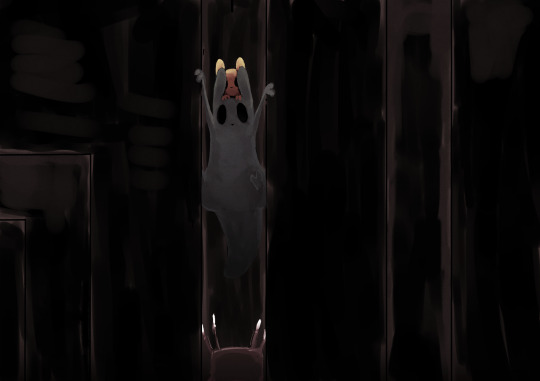
based on a tense moment in my second survivor playthrough where i went from outskirts -> drainage -> filtration -> sub -> outer expanse
#rain world#rain world downpour#slugcat#slugpup#filtration system#rain world art#rw art#art#my art#black lizard#subterranean
107 notes
·
View notes
Text











So, this is how my Hunter play through ended.
Who ever decided to let the Hunter find Slugpups, I hope you step in a puddle with your socks on
(I don't actually mean that, I was just really sad that I had to leave them behind)
#rain world#rain world downpour#slugcat#rw hunter#slugpup#rain world slugcat#rain world spoilers#mini comic#rain world hunter#rain world fanart#Rain world fan comic#I think I tamed the cyan lizard the last time I was in the subterranean so thats why it was following me#I named the pup Kiddo and tried not to get too attached but it was too late
682 notes
·
View notes
Text
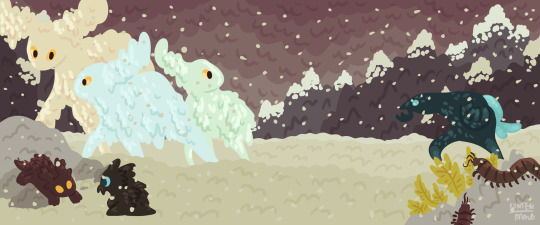
The Tundra Era
In the beginning of the world, there was nothing but cold tundra. Unlike most planets who have a warm magma filled core, the planet of rainworld has a cold void fluid core, with the only natural heat coming from the sun. The world is a freezing tundra with almost nightly blizzards, but not without life, as some creatures have adapted to its freezing ways.
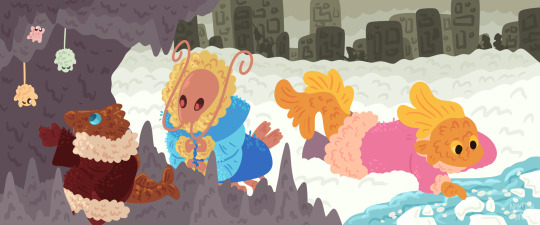
The Ancients Era
Soon, an intelligent species forms form the barren wastelands, known simply as the ancients. The ancients in their form resembled closely to aquatic fishes and insects of our world. They too adapted to their frozen environment, living in caves and underwater homes at first, and then building their own homes and citadels. At this time, they were unaware of their eternal life.

The Karmic Era
The great problem has now been made aware to the ancients, and thus the karmic religion is born. At this time only the first five karma symbols are made known to the ancients, and they do everything in their power to rid themselves of these urges, with very limiting success. It’s around this time that the ancients don their signature masks and adorned clothing as well.

Void Fluid Discovery
While drilling and constructing a train system, the ancients come across stranger structures, indicating a civilization before them. Engineers are soon replaced with paleontologists to dig and study these stranger remnants. As they continue to dig, some start having strange dreams and hallucinations of moving stars, strange worms, an empty void, until they come across the depths, and subsequently the void fluid is discovered

Void Fluid Revolution
With the introduction of the void fluid, ancient society flourishes, now they have a proper way to die. Time is spent expanding the depths, building statues and making sacrifices to the void. Their technology also expands exponentially, now able to make large factories and farms to provide for themselves. The next several karma symbols are also made known to the ancients. However echos are soon discovered in the world, fearful that the void may not have been the perfect solution they were looking for, the ancients seek another solution. This leads to the creation of the iterator, whose purpose is to find a solution to the great problem without the void. During this time, a new boom in the ancients is found, more iterators are made because of their many uses. During this time purposed creatures are brought to life to assist the ancients and iterators. It is also known during this time, that the ancients created the shelters and pathways, a place for creatures to rest in and navigate across the world that had become habituated with urban development. The world is now warmer, with the memories of a cold tundra seeming more like a dream than anything. However despite all the good times, the void is not stupid, and it certainly is displeased that the ancients who once worshipped it were now seeking another solution

The Mass Ascension Event
The great ascension was an interesting, and frightening time. Iterators noticed how more and more ancients were going to ascend, and noted how their reasonings were barely understandable. Other ancients noted how the ones going to ascend seemed almost robotic. The more frightening thing, ancients who previously had no desire in ascension, would find themselves seeking, almost yearning it, the next cycle. More and more ancients were going to ascend, and less were born. The remaining ancients during the last few years of their kind were terrified, it seemed as though every one of their kind was infected with an invisible ailment forcing them to ascend, wether they were ready or not. Some stuck by the iterators begging them to prevent them from leaving to ascend. Others traveled outside of the iterators can, to the corners of the world away from any depths entrances. Any efforts were for naught however, as the remaining ancients went to ascend as well, leaving none behind.

Post Ancient Era
Many years passed after the ancients disappeared, and the world had adapted to the structures that they had left behind. The animals were now used to the unnatural shelters and pathways that the ancients had originally constructed for them, and the iterators who were once tasked with finding a solution to the great problem now mostly did their own thing, including helping lesser creatures on their way to ascension. The slugcat campaigns also take place in this era.

Shelter Destruction
Not everything lasts forever, and this includes the ancients’ constructions. The iterators collapse due to entropy, the world losing its main heat source and being plunged into an icey torrent of blizzards. The shelters that the ancients once made to shield creatures from precipitation, also fell from the constant blizzards and entropy, leaving the creatures who once depended on them alone to brave the elements. A mass extinction follows these events, causing creature, both inorganic and natural, to die out or seek ascension to escape their miserable circumstance.
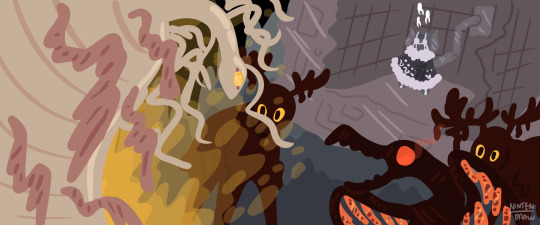
Everything Must Go
Soon, the void itself releases from its previous underground home, to pull the remaining memories and remnants of this civilization down to the depths and rubicon.
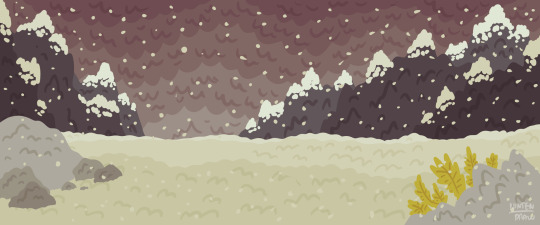
The Tundra Era again
Thus, with the remainder of the ancients gone, the world is left an endless tundra once more, but soon life will start to evolve to this cold wasteland, and soon, an intelligent species of aquatic descent will walk upon the ground, and perhaps, like the civilization before them, seek a way out of this world
#rain world#rain world fanart#rain world art#rain world downpour#rainworld#rain world slugcat#rain world ancients#rain world spearmaster#rain world artificer#rain world gourmand#rain world hunter#rain world survivor#rain world monk#rain world rivulet#rain world Saint#looks to the moon#wow this took so long but I’m glad I got it down before artfight#basically my interp of the rainworld timeline and the worldly cycle#for those confused the ancients are gonna basically come back at the end#and the stuff they found in the depths and subterranean were basically from themselves from the past cycle#and the void didn’t like how they stopped worshiping them and worshipped the iterators#so they kinda killed them off to start anew
569 notes
·
View notes
Photo

day 28 - Anniversary
happy anniversary to my favorite video game ever . play rain world (vanilla)
#rain world#rain world fanart#rain world art month#rwartmonth#slugcat#lineless#mural#looks to the moon#five pebbles#guardian#vulture#void sea#farm arrays#subterranean#shoreline#sky islands#miros bird#wild draws#wild draws rain world
1K notes
·
View notes
Text

monk card/poster!!!!!
#THEY CAN NEVER MAKE ME HATE YOU MONK………#MONKEY DONKEY I LOVE YOU#i actually drew this one back in April I just didn’t bother to post it until now lol#also the background is based on subterranean since that place makes me feel very calm#rain world#rain world monk#rain world fanart#rain world fan art#rw
40 notes
·
View notes
Text

"ATTENTION ALL SANITATION WORKERS!! Do not bring home, consume, or otherwise take flora OR fauna from the upper tunnels! You are here to REMOVE and DISPOSE of these. You are CLEANING. We're all very well aware of the muck these things live in, and I'm very sure you do not want to ingest any of that! Heavy metals poisoning is not covered by the City's graciousness!!! - Management"
or; Worm explores an ecosystem in miniature.
#YAY FIRST BIG POST FOR MY HEADWORLD#this is in the warrens. a dense network of subterranean pipes and tunnels beneath the God-Machine City#certain wings of it receive enough sunlight and little enough outside presence to form little habitats#try to spot every critter!#world: apoptosis#artists on tumblr#original art#krita#speculative evolution#spec bio#whaletrawl original
28 notes
·
View notes
Text

Subterranean
#rain world#rain world fanart#rw subterranean#rw region#worm grass#landscape#subway station#underground#digital art#myart
34 notes
·
View notes
Text



Azj-Kahet 🕸️🕷️🕸️
#of course I love the subterranean city all about spiders!! duh#the war within#war within#world of warcraft#wow#warcraft#wowedits#wow mine#azj-kahet#gaming scenery
26 notes
·
View notes
Text



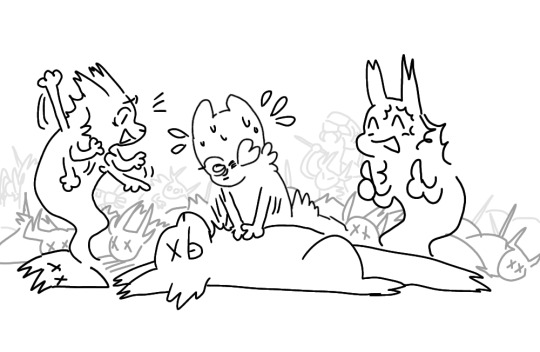

Some rw stuff
#rain world#art#rivulet#artificer#hunter#moon#nsh#First one is based on some ship art we found#Second one is discord#Third one is for a shitpost I can't share cuz it's the b*tchy b*mbos one and it's doesn't vibe with my blog#Fourth one is me (dead and trying to explain the revivify mod) my friend's gf (alive and trying to revive with really bad lag)#And my friend (also dead and getting revived)#We were all arti and in subterranean#We- the two significantly more experienced players- died in this huge war trying to escape a pipe#So she's trying to get at least one of us alive to save her but while she's struggling#More and more enemies and scavs are trying to get thru this pipe#So there's this absolute pile of bodies surrounding us and it just keeps getting larger while the enemies fight#She eventually died to a scav that somehow got thru#Last one I don't even remember
69 notes
·
View notes
Text

Sun says hello.
531 notes
·
View notes